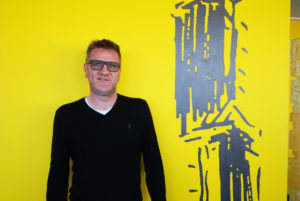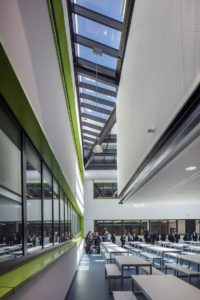 Richard Hyams, Founder and Director of astudio, espouses the importance of future-proofing our built environment and highlights how people and the planet can benefit from new approaches to architecture.
Richard Hyams, Founder and Director of astudio, espouses the importance of future-proofing our built environment and highlights how people and the planet can benefit from new approaches to architecture.
As England is in another national lockdown, initiatives that prioritise wellbeing, community and sustainability are high on the agenda for urban planners looking ahead in 2021. Our built environment reflects our values as a society — and in that sense, the design, quality, and distribution of our buildings are more than aesthetic considerations, but social and even political ones too.
Architecture that reflects a social and environmental conscience will help build a better future for our communities and our planet. Innovative construction methods, for instance, will better equip school buildings to provide for our younger generations, while public realm design projects will benefit from communities’ collaboration. Moreover, new approaches to space will improve access to housing, and cutting-edge technologies will breathe sustainability into our built environment.
Building better education
Schools have had to adapt to a fluctuating situation throughout the pandemic, and with the latest lockdown seeing doors close, governing bodies are exploring new ways to evolve estates. Modular construction is one solution being explored to deliver timely long-term solutions to curriculum disruption.
Embracing modular construction is able to make schools more resilient against future closures, for example, as temporary classrooms can be erected quickly to keep capacity high and disruption low. astudio’s modular building programme saves more than 75% of building time by delivering prefabricated structures directly to site. Moreover, these structures can then be disassembled and relocated, enabling local authorities to adopt a flexible approach to varying demand.
Furthermore, factory construction of modular buildings is more efficient, cost-effective, and environmentally friendly than traditional processes through reduction of waste. A factory setting, where supply chains can be more closely controlled, facilitates easier procurement of sustainable materials. Moreover, reducing building time by three quarters minimises air and noise pollution onsite, protecting the health of pupils and the planet.

With communities, for communities
A finished building is not the end of the story — it should serve the needs of the communities for whom they are built for the long-term. With this in mind, urban planners are recognising the benefit of public opinion to inform the design of spaces, ensuring spaces are inclusive and meet the needs of the community.
Last year’s lockdowns, for example, highlighted the new premium placed on outdoor space, with 59% of people going for walks to help cope with the stress of the pandemic. With COVID-19 expected to have a long-term impact on our mental health, improved access to outside amenity through design is immensely beneficial for public wellbeing.
Furthermore, community building projects should involve communities themselves before foundations have even been laid. By leveraging emerging technology such as virtual reality tools at the consultation stage, architects can empower buildings’ future residents to provide valuable input on how their needs can best be served. This was astudio’s approach to the redevelopment of Kingston Academy, where pupils, teachers and parents used VR headsets to explore their future learning environment.
Home is where the space is
While the pandemic has necessitated an urgent rethink of how we relate to our urban spaces, this has provided a welcome opportunity to bring our built environment up to speed with modern demands. In particular, new approaches to space can deliver a much-needed boost in our housing capacity.
With the UK consistently falling behind its housebuilding targets, there are opportunities for local authorities to invest in redevelopments that address the gap. astudio’s Sugden Way project in Barking, for instance, helps redress London’s affordable housing shortage with cost-efficient socially rented apartments. Their flexibility of arrangement and façade treatment enables schemes such as these to fit in within various building contexts.
Technology assists us in improving the quality of space for residents, which will become increasingly important in light of another national lockdown. As well as accommodating social distancing in public areas, social housing projects should ensure that living spaces are not just easy on the eye, but also good quality in use for people who call them home.
 Living alongside our environment
Living alongside our environment
A rare silver lining of lockdowns across the world has been the subsequent improvement in the planet’s health. When the pandemic eventually recedes, we can build on this opportunity to limit our environmental damage by prioritising sustainability in our urban schemes.
Innovating is happening at breath-taking pace — ‘algae living walls’ may sound like science fiction, but they provide a very real means of helping buildings become self-sufficient. These layers of algae compounds can be grown waste-free and integrated within exterior walls systems, where they sequester carbon from the air and convert it into biofuel.
These new technologies can be paired with simple sustainable strategies for greater impact. For the redevelopment of St Paul’s Way Trust School, for example, astudio used natural ventilation and high thermal mass to reduce emissions by 60% compared to a typical school. Indeed, a range of solutions will be needed to bring buildings of all types up to new sustainability standards.
People and the planet can both benefit from new approaches to architecture, from the modular construction of school buildings to the shift of sustainability to centre-stage. Meanwhile, satisfying communities’ wants and needs, both indoors and out, will help future-proof our urban environments. Architecture is well-placed to facilitate social and environmental change — let’s hope we seize the opportunity in 2021.
Header image shows astudio’s Sugden Way housing project in Barking.









